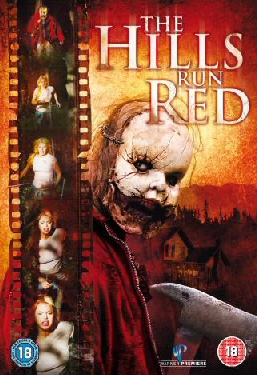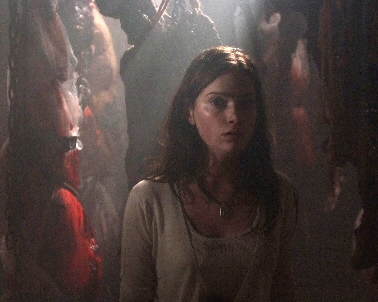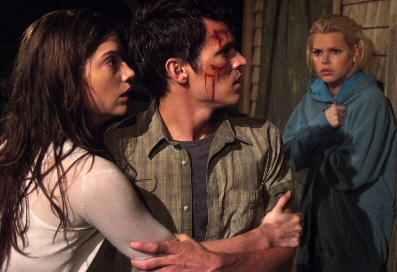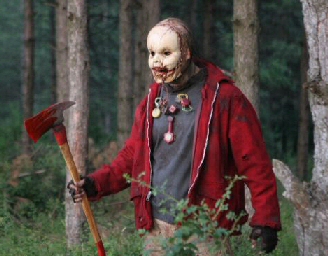It's been some time since SGM spoke to filmmaker Dave (The Dead Hate The Living) Parker so with the much anticipated DVD release of his acclaimed new genre-bending movie THE HILLS RUN RED it was high time we caught up with him again so SGM's Paul Bird sat him down after a crowd pleasing festival screening to discuss his latest terror treat in our exclusive interview...

SGM: A fair time has passed since we last interviewed you. What have you been up to?
DP: I ended up working on a lot of documentaries after DHTL. I edited a couple of films for Full Moon, then I left and got involved with Robert Burnett, who's one of the producers of Hills, doing behind-the-scenes documentaries and retrospective features for DVDs. The first one we did was The Usual Suspects.
He was working on Lord Of The Rings at the time, and needed someone to cut the feature together while he was in New Zealand, so I ended up doing it. That led into the Special Edition of X-Men and then X2, and Chronicles Of Narnia. We went to New Zealand for six months and shot every single day of the making of that film.
During that time I was working with Mike Mendez, who made Gravedancers and The Convent. We did this documentary called Masters Of Horror - before the TV show came out! It was for Showtime, and we had Bruce Campbell host it. This was tributes and retrospectives with all the masters - Wes Craven, John Carpenter, Guillermo Del Toro, John Landis, Tobe Hooper - almost all the guys we could get! We didn't get Cronenberg and Coscarelli, though. I wanted those guys. But the film went through Universal, so we ended up picking mostly Universal films as we could get footage from them. It just so happened that all these guys had worked with them, or we could licence stuff.
From that we went onto features for Superman Returns and Spiderman 2. We never really treated them as behind the scenes featurettes - our documentaries for those were three and a half hours long! To us, we were doing very personal films - because we were on the set so long, we really interacted and got to know the cast and crew. I'm really proud of the results.
SGM: How do you feel your experiences with these documentaries have helped you?
DP: Basically, I look at that period of years as going through graduate school. My professors were Sam Raimi, Bryan Singer, Ridley Scott, Andrew Adamson - We had so much contact with them we really got to review their processes. It was a great educational experience for me, seeing these guys on big studio movies. To me it was invaluable. So many things you'd never consider when you make a movie independently - this really prepared us for Hills Run Red.
SGM: So how did the film come to be? Was it always intended as a big studio movie?
DP: The project came to Robert and myself during Superman Returns. There was a company out in New York called Fever Dreams, who'd made some low budget movies like Shadow: Dead Riot. They sent us the scripts for two films, and one was Hills - the other was Wicked Lake, which was made by other people - but I responded better to Hills. You know - it had a masked killer and everything. At that time - about three years ago - they hadn't been making masked killer movies for a while and I was like "Oh, this is great! I'd love to do something like this!"
We put together a presentation, artwork, new ideas. I took the script and made some changes, and they agreed. They liked what we had to say, so they gave us the go ahead to bring in splatterpunk author David Schow to help with the script.
At this stage it was going to be a $350,000 movie - real quick and dirty - and at the time I was like "is this really my dream project? Is this exactly what I want to do?" That was scary, and I was concerned as there were some big similarities with The Dead Hate The Living - you know, a group of people making a film, and I was like "Oh man, people are just going to think that I'm doing the same material over again" and it wasn't me - I didn't generate it. But that was the only story element they wanted to maintain, so we changed it somewhat - people doing a documentary - but those were really the only elements we ended up keeping from the original script. Now we had someone like Dave Schow, we wanted to show his style off and it would be more interesting.
SGM: I'd heard you put together a shorter version of the film initially.
DP: While we were developing the script, we were asked for a teaser for the film - something to show at Cannes to get some investment. I think it was also a director's test - they wanted to check out that I could actually deliver. We came up with this idea "well, if this guys killing everyone and he's a movie maker, he's going to need an audience". You know - what's he going to do with all the victims? They're the audience!

The concept was this girl in a cinema, strapped with barbed wire to a chair and the whole theatre's filled with corpses. The killer bursts through the door as she's trying to get free and he's stalking down towards her. We storyboarded the whole thing and put it together. Lots of friends and filmmakers were corpses in the audience! We shot it in an old grindhouse cinema in New York.
During the time we were finishing this up, Bryan Singer came on set. He liked the project a lot and said it should be a Warner Brothers movie. We were like "Oh yeah, Bryan, right... ok!" so he made a call to Diane Nelson, who runs Warner Premiere. They took the script and we showed them the teaser, and I thought that'd be it. When you read the script it's so nasty, so not studio material, that I was like "it'll never happen". And then a couple of weeks later we got a call saying they really liked the script, we have this deal with Dark Castle, and we want to make this movie. I couldn't believe it. I was like "Are you shitting me? Really?" It was like winning the lottery! The whole game changed. Rather than a low budget movie, it was now like 3.5 million!
SGM: With the studio backing and increase in budget, did this change the project at all?
DP: It changed a lot of things. Obviously, the calibre of actors we could afford changed. The location changed - We were originally talking about shooting in Mexico or Africa, then we settled on Bulgaria. I loved the idea of going somewhere else and living there while we made the movie.
The other thing that changed was, instead of two producers to deal with, there was now six all with their own things they were looking for. It was really exciting - again, it was a very new game for me. At an independent level you get used to doing everything yourself. Now we had people to deal with stuff, it became more supervising, overseeing and communicating what we needed.
SGM: How did you find this? Did you prefer it to the low budget, independent experience?
DP: Well, there's always an independent heart, but the thing that I realised, even when we were doing the documentaries, is that your job as a director, whether you're making a movie for two dollars or two hundred million, is always the same. It's really about having better experienced people to help create your movie. Having more tools at your disposal. And time! Time is something you have to be incredibly creative with when you have a small budget. You look at some of the things Sam Raimi or Peter Jackson shot with no money, but people forget they made those films over the course of three or four years. That really changed for us - Even on a small budget movie, most of the time, unless it's your own money, you won't have the luxury of being able to shoot over the course of several years. You go to a studio, even a small studio, there are certain freedoms that you're giving up. That's just the nature of it. And there's more commerce to think about. You can't be totally off the wall, as they've got more say in what goes in, but overall this is still the most disturbing, fucked-up, movie that Dark Castle has done, subject matter wise. Thematically, we've still managed to get this subversive thing in there.

SGM: Certainly some of the gore you've got there is pretty strong, and the implications in the latter part of the film are really nasty. Did you have to make any concessions?
DP: Yeah, as much as what we left in, what's being put out is the R-Rated cut of the movie. The unrated cut has got even more nasty stuff that is not gore, per se. It's that age old curse of sexual content and violence in the same scene. They always seem ok if they're separated, but in the same scene - that's where problems occur. It was one of the things that initially they embraced, and we'd felt very creative when we wrote it. It imbues the movie with more character, enhancing more of the story, so we had to be a little tricky when we cut that down. We didn't want to lose those moments that informed the audience stuff about the characters. That was really tricky. But did they make the right choice? Initially they said that the DVD would get released unrated, but during editing they had a policy change and they aren't releasing anything unrated anymore. We were like "Oh, man!" but we had to leave stuff out to keep everything going.
I like this movie uncut - it's really, really, messed up, but I'm really close to it. Other people have seen the uncut version and they think it may have been too much, that it went into such a dark area that people may have started laughing because it's got so crazy. So would it be better if the stuff was in there or not? I don't know. Hopefully one day, if it sells well enough, they'll say "alright, let's do the unrated version on Bluray" or something like that.
SGM: The film itself looks amazing. The attention to detail is superb, such as the old film really looking like it came from the 80's. But what I really loved where the movie posters you had in the film.
DP: I have a friend named Stephen Romano. He's a writer, who wrote Incident On And Off A Mountain Road for Masters Of Horror and co-wrote Bubba Nosferatu. He was doing this book project called Shock Festival. He created about 300 fake movies, and created these elaborate back stories for them, then went out to artists who designed all the posters for them. Before the book came out he was showing me some of the posters and I didn't want to reference real movies in Hills - I wanted to create our own universe. So we made a deal. Those posters are all creations that he has in the book. He really understands the aesthetic of those old posters. The producers were worried at some points - "I know this is a real movie! You have to move that poster!" and I said "it's not - get on the phone with the lawyer. It's already been cleared!" It was funny, because they were still saying "I know I've seen that movie." - Oh no you haven't.
SGM: The masked killer, Babyface, is another piece of great design. Could you talk a bit about that?
DP: To begin with, the killer was never really described. Only sort of like a skinned baby's face stretched over it. I wasn't too hot on that. The name alone - I just had this image of a porcelain doll mask, definitely inspired by Deep Red or Tourist Trap. I started working with my conceptual artist, Michael Broom, and that design was one of the first things we came up with. We had a year or so from that point until we did the movie, but we kept coming back to this mask. The doll's head and the broken jaw. There was this psychology behind it. In the original movie the killer wore a doll mask, and this guy really wants to be the killer so he sews it onto his face. And then over time, people fight back, so they break the mask and it gets scarred up and he's repaired it with a jawbone, things like that. It really became this very creepy looking image.
We had big discussions about killers wearing masks in movies. I'm not a big fan of, say, the killer wearing a ski mask or something drab and every day. I mean, I really like the movie Maniac, and luckily Joe Spinell is an incredibly unique looking person, but most of the time I find serial killer movies like that uninteresting. I like the fantasy element. So we were talking about things like the Michael Myers mask, and how random that was and how iconic that became. Or who would have thought a hockey mask would become more associated with Jason than the sport? We really went into the philosophy and psychology of the mask. We wanted something nightmarish. It was important to me that I gave the audience a great horror character with this.

SGM: It's interesting you talk about the mask worn in the original film and then the nastier modern version, as part of the film almost seems like a fight between the 80's style slasher movie and modern Torture Porn. Do you feel there's an inherent conflict between them?
DP: That shows my sensibilities, and Dave Schow's sensibilities towards the genre. We're just tired of it, the torture porn stuff. I kind of miss the fun in movies. And I know we have torture scenes in this movie, but hopefully some of the discussions the characters have make the point of why they're in there. It's sort of like "isn't this stuff with the masked killer running around more fun? Aren't you enjoying that rollercoaster ride more than this stuff?" It's a debate. Are we out of touch with what modern horror is? I don't know. I don't think so. I think the torture stuff is just all that people have been getting recently. But me, I'm not having fun with it anymore.
What I feel fortunate for is that I'm an evangelist for the horror filmmaking group. It's pretty tight-knit. A lot of us are here at Frightfest. We're trying to do different things, not just remake movies or torture stuff. Our influences aren't that - they're the 80's, the early 80's, you know - Fright Night, the slasher movies. To me there's a sense of fun and enjoyment that's missing now, and there seems to be a lot of mean spiritedness in many of today's movies. I like walking out of the movies feeling excited, not depressed. That's not to say that some really good, challenging movies haven't come out. Martyrs is great. Poetic in its brutality. And I think the first Saw is a really great movie. It gets labelled torture porn, but I don't think it is if you really watch it closely. So I don't know if we're out of touch with people, but I don't see the entertainment value in watching people being tortured for prolonged periods of time.
SGM: With that said, where do you think horror is heading?
DP: I hope away from cannibalising itself! All this sequel, sequel, remake, spinoff, based on a toy. Luckily, we're seeing the roots and bits and pieces of it, and we're getting back to individual voices. I know my friends and I are making movies were we aspire to some kind of voice. Some kind of vision or stance that people can recognise. Okay, that doesn't mean me continuing to make movies about other people making movies, though!
I think for the foreseeable future we're going to see more remakes. Or sequels to remakes. It's gotten really bad recently and seems to be all a studio wants. But they wouldn't make them if people weren't going, so I don't know what that says. But I do know the audience is hungry. I hope to see the studios taking more chances with their choice of material.
SGM: And what's next for Dave Parker?
DP: I'm working on a couple of projects now. Very different from this. Dave Schow has a couple of scripts that I'm interested in, and I'm working with John Skipp who's another horror author. Yeah - I'm making my way through the splatterpunks! I'm going to do a Skipp one, Schow I'll work with anytime, ever. I'd love to adapt a Richard Laymon novel. You throw the dice out there and see what happens. You try to guide your destiny the best you can, but it's sometimes just where the wind goes. You just have to make the best out of whatever opportunities you get, very much like this one was.
SGM: And on that philosophical note - Dave Parker, thank you very much.
Special thanks to Dave, Warner Home Video and Diana Privitera